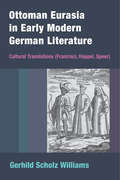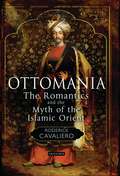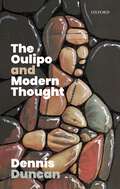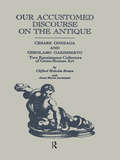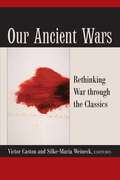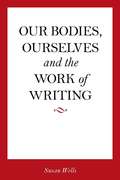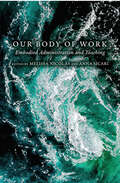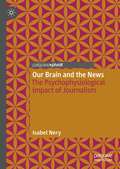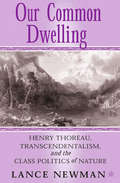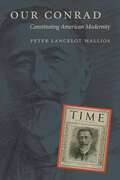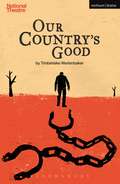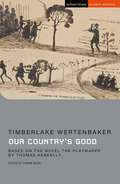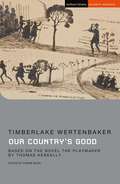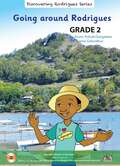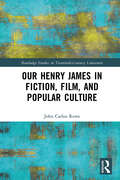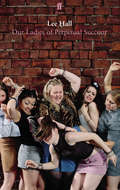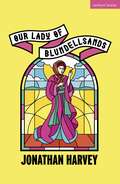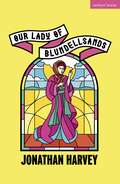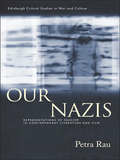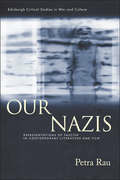- Table View
- List View
Ottoman Eurasia in Early Modern German Literature: Cultural Translations (Francisci, Happel, Speer)
by Gerhild Scholz WilliamsEven a casual perusal of seventeenth-century European print production makes clear that the Turk was on everyone’s mind. Europe’s confrontation of and interaction with the Ottoman Empire in the face of what appeared to be a relentless Ottoman expansion spurred news delivery and literary production in multiple genres, from novels and sermons to calendars and artistic representations. The trans-European conversation stimulated by these media, most importantly the regularly delivered news reports, not only kept the public informed but provided the basis for literary conversations among many seventeenth-century writers, three of whom form the center of this inquiry: Daniel Speer (1636-1707), Eberhard Werner Happel (1647-1690), and Erasmus Francisci (1626-1694). The expansion of the Ottoman Empire during the sixteenth and seventeenth centuries offers the opportunity to view these writers' texts in the context of Europe and from a more narrowly defined Ottoman Eurasian perspective. Ottoman Eurasia in Early Modern German Literature: Cultural Translations (Francisci, Happel, Speer) explores the variety of cultural and commercial conversations between Europe and Ottoman Eurasia as they negotiated their competing economic and hegemonic interests. Brought about by travel, trade, diplomacy, and wars, these conversations were, by definition, “cross-cultural” and diverse. They eroded the antagonism of “us and them,” the notion of the European center and the Ottoman periphery that has historically shaped the view of European-Ottoman interactions.
Ottomania: The Romantics and the Myth of the Islamic Orient
by Roderick CavalieroRomanticism had its roots in fantasy and fed on myth'. So Roderick Cavaliero introduces the European Romantic obsession with the Orient.Cavaliero draws on a life-time's research in Romantic literature and introduces a rich cast of leading Romantic writers,artists,musicians and travellers,including Beckford,Byron, Shelley,Walter Scott,Pierre Loti,Thomas Moore,Rossini,Eugene Delacroix,Thackeray and Disraeli,and a host of other Romantics,who were drawn to the Orient in the 18th and 19th centuries.They luxuriate in its exotic sights,sounds,literature and,above all, in the prevailing mythology.Cavaliero analyses the Romantic vision where,as Byron writes, there are 'virgins soft as the roses they twine',but lays bare an underlying vision of cruelty and oppression, and of societies based on domestic or prisoner slavery - anathema to the 19th-century Romantic. The overarching myth was that of the Ottoman Empire,a huge and exotic superpower,an empire to rival Rome,a major threat to Europe, with an invincible military record ruled by a Sultan with absolute, even feckless, power of life and death over his subjects who lived to 'delight his senses'.But to the Romantics,fear of the absolute ruler was overlaid by frissons of oriental luxury.Thus the Ottoman Sultans were the heirs of the iconic Caliphate of Harun ar Rashid in the fabulous Arabian Nights Entertainments.Coleridge's dream of the Orient in Kubla Khan was not of the barbaric grandeur of the global Mongol empire but that of a 'stately pleasure dome in Xanadu' among incense-bearing trees and untroubled forests. Moore's Lalla Rookh was set in his visionary vale of Kashmir and is a love story in 'a land of kingfishers and golden orioles' with the backdrop of the mighty Moghul Empire. Scott was obsessed by the chivalry of the Crusades on both sides and Disraeli was fascinated by the interplay of the Abrahamic faiths and the hopes of peace in the Holy Land. Dualism runs through Romantic writing even when European realpolitik and modern nationalism are involved - as in the Greek revolt against Ottoman rule and the decline of Turkey as a great power. But above all for the Romantics the Orient remained mysterious and inviting. Cavaliero's Ottomania will delight all readers interested in tales of the exotic Orient, and the literature of the Romantic movement - a rich treasure-house of poets, novelists and travellers.
The Oulipo and Modern Thought
by Dennis DuncanThe impact of the Oulipo (Ouvroir de Littérature Potentielle), one of the most important groups of experimental writers of the late twentieth century, is still being felt in contemporary literature, criticism, and theory, both in Europe and the US. Founded in 1960 and still active today, this Parisian literary workshop has featured among its members such notable writers as Italo Calvino, Georges Perec, and Raymond Queneau, all sharing in its light-hearted, slightly boozy bonhomie, the convivial antithesis of the fractious, volatile coteries of the early twentieth-century avant-garde. For the last fifty years the Oulipo has undertaken the same simple goal: to investigate the potential of 'constraints' in the production of literature—that is, formal procedures such as anagrams, acrostics, lipograms (texts which exclude a certain letter), and other strange and complex devices. Yet, far from being mere parlour games, these methods have been frequently used as part of a passionate—though sometimes satirical—involvement with the major intellectual currents of the mid-twentieth century. Structuralism, psychoanalysis, Surrealism, analytic philosophy: all come under discussion in the group's meetings, and all find their way in the group's exercises in ways that, while often ironic, are also highly informed. Using meeting minutes, correspondence, and other material from the Oulipo archive at the Bibliothèque nationale de France, The Oulipo and Modern Thought shows how the group have used constrained writing as means of puckish engagement with the debates of their peers, and how, as the broader intellectual landscape altered, so too would the group's conception of what constrained writing can achieve.
The Oulipo and Modern Thought
by Dennis DuncanThe impact of the Oulipo (Ouvroir de Littérature Potentielle), one of the most important groups of experimental writers of the late twentieth century, is still being felt in contemporary literature, criticism, and theory, both in Europe and the US. Founded in 1960 and still active today, this Parisian literary workshop has featured among its members such notable writers as Italo Calvino, Georges Perec, and Raymond Queneau, all sharing in its light-hearted, slightly boozy bonhomie, the convivial antithesis of the fractious, volatile coteries of the early twentieth-century avant-garde. For the last fifty years the Oulipo has undertaken the same simple goal: to investigate the potential of 'constraints' in the production of literature—that is, formal procedures such as anagrams, acrostics, lipograms (texts which exclude a certain letter), and other strange and complex devices. Yet, far from being mere parlour games, these methods have been frequently used as part of a passionate—though sometimes satirical—involvement with the major intellectual currents of the mid-twentieth century. Structuralism, psychoanalysis, Surrealism, analytic philosophy: all come under discussion in the group's meetings, and all find their way in the group's exercises in ways that, while often ironic, are also highly informed. Using meeting minutes, correspondence, and other material from the Oulipo archive at the Bibliothèque nationale de France, The Oulipo and Modern Thought shows how the group have used constrained writing as means of puckish engagement with the debates of their peers, and how, as the broader intellectual landscape altered, so too would the group's conception of what constrained writing can achieve.
Our Accustomed Discourse on the Antique: Cesare Gonzaga & Gerolamo Garimberto, Two Renaissance Collectors of Greco-Roman Art
by Clifford M. BrownFirst Published in 1993. Including a guide to the collecting of this historical data in the latter part of the sixteenth century, betwen 1550 and 1575 this work includes the relationship between Cesare Gonzago and Gerolamo Garimberto and their evaluations on antiquities and archaelogical advisings.
Our Accustomed Discourse on the Antique: Cesare Gonzaga & Gerolamo Garimberto, Two Renaissance Collectors of Greco-Roman Art
by Clifford M. BrownFirst Published in 1993. Including a guide to the collecting of this historical data in the latter part of the sixteenth century, betwen 1550 and 1575 this work includes the relationship between Cesare Gonzago and Gerolamo Garimberto and their evaluations on antiquities and archaelogical advisings.
Our Ancient Wars: Rethinking War through the Classics
by Victor Caston Silke-Maria WeineckMany famous texts from classical antiquity—by historians like Thucydides, tragedians like Sophocles and Euripides, the comic poet Aristophanes, the philosopher Plato, and, above all, Homer—present powerful and profound accounts of wartime experience, both on and off the battlefield. These texts also provide useful ways of thinking about the complexities and consequences of wars throughout history, and the concept of war broadly construed, providing vital new perspectives on conflict in our own era. Our Ancient Wars features essays by top scholars from across academic disciplines—classicists and historians, philosophers and political theorists, literary scholars, some with firsthand experience of war and some without—engaging with classical texts to understand how differently they were read in other times and places. Contributors articulate difficult but necessary questions about contemporary conceptions of war and conflict. Contributors include Victor Caston, Page duBois, Susanne Gödde, Peter Meineck, Sara Monoson, David Potter, Kurt Raaflaub, Arlene Saxonhouse, Seth Schein, Nancy Sherman, Hans van Wees, Silke-Maria Weineck, and Paul Woodruff.
Our Bodies, Ourselves and the Work of Writing
by Susan WellsOur Bodies, Ourselves, first published by a mainstream press in 1973, is now in its eighth major edition. It has been translated into twenty-nine languages, has generated a number of related projects, and, with over four million copies sold, is as popular as ever. This study tells the story of the first two decades of the pioneering best-seller—a collectively produced guide to women's health—from its earliest, most experimental and revolutionary years, when it sought to construct a new, female public sphere, to its 1984 revision, when some of the problems it first posed were resolved and the book took the form it has held to this day. Wells undertakes a rhetorical and sociological analysis of the best-seller and of the work of the Boston Women's Health Book Collective that produced it. In the 1960s and 1970s, as social movements were on the rise and many women entered higher education, new writing practices came into existence. In the pages of Our Bodies, Ourselves, matters that had been private became public. Readers, encouraged to trust their own experiences, began to participate in a conversation about health and medicine. The writers of Our Bodies, Ourselves researched medical texts and presented them in colloquial language. Drafting and revising in groups, they invented new ways of organizing the task of writing. Above all, they presented medical information by telling stories. We learn here how these stories were organized, and how the writers drew readers into investigating both their own bodies and the global organization of medical care. Extensive archival research and interviews with the members of the authorial collective shed light on a grassroots undertaking that revolutionized the writing of health books and forever changed the relationship between health experts and ordinary women.
Our Body of Work: Embodied Administration and Teaching
Our Body of Work invites administrators and teachers to consider how physical bodies inform everyday work and labor as well as research and administrative practices in writing programs. Combining academic and personal essays from a wide array of voices, it opens a meaningful discussion about the physicality of bodily experiences in the academy. Open exchanges enable complex and nuanced conversations about intersectionality and how racism, sexism, classism, and ableism (among other “isms”) create systems of power. Contributors examine how these conversations are framed around work, practices, policies, and research and identify ways to create inclusive, embodied practices in writing programs and classrooms. The collection is organized to maximize representation in the areas of race, gender, identity, ability, and class by featuring scholarly chapters followed by narratively focused interchapters that respond to and engage with the scholarly work. The honest and emotionally powerful stories in Our Body of Work expose problematic and normalizing policies, practices, and procedures and offer diverse theories and methodologies that provide multiple paths for individuals to follow to make the academy more inclusive and welcoming for all bodies. It will be an important resource for researchers, as well a valuable addition to graduate and undergraduate syllabi on embodiment, writing instruction/pedagogy, and WPA work. Contributors: Dena Arendall, Janel Atlas, Hayat Bedaiwi, Elizabeth Boquet, Lauren Brentnell, Triauna Carey, Denise Comer, Joshua Daniel, Michael Faris, Rebecca Gerdes-McClain, Morgan Gross, Nabila Hijazi, Jacquelyn Hoermann-Elliott, Maureen Johnson, Jasmine Kar Tang, Elitza Kotzeva, Michelle LaFrance, Jasmine Lee, Lynn C. Lewis, Mary Lourdes Silva, Rita Malenczyk, Anna Rita Napoleone, Julie Prebel, Rebecca Rodriguez Carey, Ryan Skinnell, Trixie Smith, Stacey Waite, Kelsey Walker, Shannon Walters, Isaac Wang, Jennie Young
Our Brain and the News: The Psychophysiological Impact of Journalism
by Isabel NeryThis book explores the impact of news and literary journalism on human cognition and emotion. Providing an innovative analysis of psycho-physiological measures, including emotional response, perception of pain, and changes in heartbeat, Nery seeks to understand how readers react to journalistic texts. There is a growing enthusiasm in the search for understanding the processing of information, with some already arguing for the establishment of the neuroscience of communication as a new discipline. By combing neuroscience methods with communication research studies, specifically journalistic research and theory, Nery offers us a unique way of exploring and thinking about news, literary journalism, and the brain.
Our Common Dwelling: Henry Thoreau, Transcendentalism, and the Class Politics of Nature
by Lance NewmanOurCommonDwelling explores why America's first literary circle turned to nature in the 1830s and '40s. When the New England Transcendentalists spiritualized nature, they were reacting to intense class conflict in the region's industrializing cities. Their goal was to find a secular foundation for their social authority as an intellectual elite. New England Transcendentalism engages with works by William Wordsworth, Henry David Thoreau, Ralph Waldo Emerson, Margaret Fuller, Nathaniel Hawthorne, and others. The works of these great authors, interpreted in historical context, show that both environmental exploitation and conscious love of nature co-evolved as part of the historical development of American capitalism.
Our Conrad: Constituting American Modernity
by Peter MalliosOur Conrad is about the American reception of Joseph Conrad and its crucial role in the formation of American modernism. Although Conrad did not visit the country until a year before his death, his fiction served as both foil and mirror to America's conception of itself and its place in the world. Peter Mallios reveals the historical and political factors that made Conrad's work valuable to a range of prominent figures—including Fitzgerald, Faulkner, Richard Wright, Woodrow Wilson, and Theodore and Edith Roosevelt—and explores regional differences in Conrad's reception. He proves that foreign-authored writing can be as integral a part of United States culture as that of any native. Arguing that an individual writer's apparent (national, gendered, racial, political) identity is not always a good predictor of the diversity of voices and dialogues to which he gives rise, this exercise in transnational comparativism participates in post-Americanist efforts to render American Studies less insular and parochial.
Our Country's Good (Modern Plays)
by Timberlake WertenbakerObserved by a lone, mystified Aboriginal Australian, the first convict ship arrives in Botany Bay, 1788, crammed with England's outcasts. Colony discipline in this vast and alien land is brutal. Three proposed public hangings incite an argument: how best to keep the criminals in line, the noose or a more civilised form of entertainment?The ambitious Second Lieutenant Ralph Clark steps forward with a play. But as the mostly illiterate cast rehearses, and a sense of common purpose begins to take hold, the young officer's own transformation is as marked and poignant as that of his prisoners.A profoundly humane piece of theatre, steeped in suffering yet charged with hope, Timberlake Wertenbaker's Our Country's Good (based on a true story) celebrates the redemptive power of art.It premiered at the Royal Court Theatre, london, in 1988, winning the Laurence Olivier Play of the Year Award. This edition was published to coincide with a major revival production at the National Theatre, which opened on 19 August 2015.
Our Country's Good: Based On The Novel 'the Playmaker' By Thomas Keneally (Modern Plays)
by Timberlake WertenbakerObserved by a lone, mystified Aboriginal Australian, the first convict ship arrives in Botany Bay, 1788, crammed with England's outcasts. Colony discipline in this vast and alien land is brutal. Three proposed public hangings incite an argument: how best to keep the criminals in line, the noose or a more civilised form of entertainment?The ambitious Second Lieutenant Ralph Clark steps forward with a play. But as the mostly illiterate cast rehearses, and a sense of common purpose begins to take hold, the young officer's own transformation is as marked and poignant as that of his prisoners.A profoundly humane piece of theatre, steeped in suffering yet charged with hope, Timberlake Wertenbaker's Our Country's Good (based on a true story) celebrates the redemptive power of art.It premiered at the Royal Court Theatre, london, in 1988, winning the Laurence Olivier Play of the Year Award. This edition was published to coincide with a major revival production at the National Theatre, which opened on 19 August 2015.
Our Country's Good: Based on the novel 'The Playmaker' by Thomas Keneally (Student Editions)
by Timberlake WertenbakerAustralia 1789. A young married lieutenant is directing rehearsals of the first play ever to be staged in that country. With only two copies of the text, a cast of convicts, and one leading lady who may be about to be hanged, conditions are hardly ideal...Winner of the Laurence Olivier Play of the Year Award in 1988, and many other major awards, Our Country's Good premiered at the Royal Court Theatre, London, in 1988 and opened on Broadway in 1991. 'Rarely has the redemptive, transcendental power of theatre been argued with such eloquence and passion.' Georgina Brown, Independent It is published here in a new Student Edition, alongside commentary and notes by Sophie Bush.The commentary includes a chronology of the play and the playwright's life and work as well as discussion of the social, political, cultural and economic context in which the play was originally conceived and created.
Our Country's Good: Based on the novel 'The Playmaker' by Thomas Keneally (Student Editions)
by Timberlake WertenbakerAustralia 1789. A young married lieutenant is directing rehearsals of the first play ever to be staged in that country. With only two copies of the text, a cast of convicts, and one leading lady who may be about to be hanged, conditions are hardly ideal...Winner of the Laurence Olivier Play of the Year Award in 1988, and many other major awards, Our Country's Good premiered at the Royal Court Theatre, London, in 1988 and opened on Broadway in 1991. 'Rarely has the redemptive, transcendental power of theatre been argued with such eloquence and passion.' Georgina Brown, Independent It is published here in a new Student Edition, alongside commentary and notes by Sophie Bush.The commentary includes a chronology of the play and the playwright's life and work as well as discussion of the social, political, cultural and economic context in which the play was originally conceived and created.
Our Environment class 2 - MIE
by Aruna Ankiah-Gangadeen Seema Goburdhun"Our Environment" is a vibrant big book designed for Grade 2 English sessions, authored by Dr. Aruna Ankiah-Gangadeen and Dr. Seema Goburdhun, featuring illustrations by Kunal Sumbhoo. The book celebrates the diverse natural landscapes of Mauritius, engaging young learners with picturesque descriptions of prominent mountains like Le Pouce, Lion, Signal, Le Morne, and Pieter Both, along with other notable geographical features such as Candos Hill, Macchabee forest, and Grand River South East. Through vivid imagery and simple text, the book introduces students to the rich environmental elements of the island, fostering awareness and appreciation for their surroundings. The interactive sessions encompass pre-reading discussions, focused readings with vocabulary reinforcement, and post-reading activities aimed at enhancing comprehension and encouraging creativity. Seamlessly integrated with the curriculum, this big book serves as an educational tool to instill a sense of pride and belonging while nurturing English language skills among young learners within the context of their local environment.
Our Festivals class 2 - MIE
by Aruna Ankiah-Gangadeen Seema Goburdhun"Our Festivals" is an illuminating big book crafted for Grade 2 English sessions, co-authored by Dr. Aruna Ankiah-Gangadeen and Dr. Seema Goburdhun, with illustrations by Kunal Sumbhoo and Kamla Ernest. The book vividly explores the cultural tapestry of Mauritius through its diverse celebrations. It introduces young learners to the essence of various festivals like Christmas, Divali, Eid, the Spring festival, Cavadee, Ugadi, and Ganesh Chaturthi, offering glimpses into the traditions and customs associated with each occasion. Through simple yet engaging descriptions and colorful illustrations, the book invites children to delve into the festive spirit, emphasizing the significance of rituals, prayers, new attire, sharing of treats, and gathering with family during these special times. Integrated into literacy sessions, the book fosters cultural awareness, language development, and understanding among students, encouraging participation through pre, during, and post-reading activities tailored to reinforce comprehension and creative expression. This educational resource not only enriches English language skills but also instills pride and appreciation for the rich tapestry of festivals within Mauritius' multicultural landscape.
Our Henry James in Fiction, Film, and Popular Culture (Routledge Studies in Twentieth-Century Literature #1)
by John Carlos RoweOur Henry James in Fiction, Film, and Popular Culture addresses the interesting revival of Henry James’s works in Anglo-American film adaptations and contemporary fiction from the 1960s to the present. James’s fiction is generally considered difficult and part of high culture, more appropriate for classroom study than popular appreciation. However, this volume focuses on the adaptation of his novels into films, challenging us to understand James’s popular reputation today on both sides of the Atlantic. The book offers two explanations for his persistent influence: James’s literary ambiguity and his reliance on popular culture. “Part I: His Times” considers James’s reliance on sentimental literature and theatrical melodrama in Daisy Miller, Guy Domville, The Awkward Age, and several of his lesser known short stories. “Part II: Our Times” focuses on how James’s considerations of changing gender roles and sexual identities have influenced Hollywood representations of emancipated women in Hitchcock’s Rear Window and Peter Bogdanovich’s The Last Picture Show, among others. Recent fiction by authors including James Baldwin and Leslie Marmon Silko also treat Jamesian notions of gender and sexuality while considering his part in contemporary debates about globalization and cosmopolitanism. Both a study of James’s works and a broad range of contemporary film and fiction, Our Henry James in Fiction, Film, and Popular Culture demonstrates the continuing relevance of Henry James to our multimedia, interdisciplinary, globalized culture.
Our Henry James in Fiction, Film, and Popular Culture (Routledge Studies in Twentieth-Century Literature #1)
by John Carlos RoweOur Henry James in Fiction, Film, and Popular Culture addresses the interesting revival of Henry James’s works in Anglo-American film adaptations and contemporary fiction from the 1960s to the present. James’s fiction is generally considered difficult and part of high culture, more appropriate for classroom study than popular appreciation. However, this volume focuses on the adaptation of his novels into films, challenging us to understand James’s popular reputation today on both sides of the Atlantic. The book offers two explanations for his persistent influence: James’s literary ambiguity and his reliance on popular culture. “Part I: His Times” considers James’s reliance on sentimental literature and theatrical melodrama in Daisy Miller, Guy Domville, The Awkward Age, and several of his lesser known short stories. “Part II: Our Times” focuses on how James’s considerations of changing gender roles and sexual identities have influenced Hollywood representations of emancipated women in Hitchcock’s Rear Window and Peter Bogdanovich’s The Last Picture Show, among others. Recent fiction by authors including James Baldwin and Leslie Marmon Silko also treat Jamesian notions of gender and sexuality while considering his part in contemporary debates about globalization and cosmopolitanism. Both a study of James’s works and a broad range of contemporary film and fiction, Our Henry James in Fiction, Film, and Popular Culture demonstrates the continuing relevance of Henry James to our multimedia, interdisciplinary, globalized culture.
Our Ladies of Perpetual Succour
by Lee HallListen, girls, if we stick together there's no ways we'll even get to the second round...Young, lost and out of control, a bunch of Catholic schoolgirls go wild for a day in the big city, the singing competition a mere obstacle in the way of sex, sambuca and a night back home with the submarine crew in Mantrap.Funny, sad and raucously rude, Lee Hall's musical play Our Ladies of Perpetual Succour, adapted from Alan Warner's novel The Sopranos, premiered at the Traverse Theatre in August 2015, in a production by the National Theatre of Scotland and Live Theatre.Our Ladies of Perpetual Succour won the Olivier Award for Best New Comedy 2017.
Our Lady of Blundellsands (Modern Plays)
by Jonathan HarveyIt's no secret that Sylvie is unravelling. Frozen in time in her Blundellsands house, she inhabits a fantasy world that never was. Garnet, her sister, is older and wiser – and wearier, with her shopping lists and tired love. She's always fanned the flames of Sylvie's fantasies. Because if she didn't… who knows where they'd both end up?But now the whole family's up in Liverpool for a birthday, and Garnet's got a secret of her own to pass on. There'll be a party… but it's not going to be pretty.Welcome to a family more messed up than your own.
Our Lady of Blundellsands (Modern Plays)
by Jonathan HarveyIt's no secret that Sylvie is unravelling. Frozen in time in her Blundellsands house, she inhabits a fantasy world that never was. Garnet, her sister, is older and wiser – and wearier, with her shopping lists and tired love. She's always fanned the flames of Sylvie's fantasies. Because if she didn't… who knows where they'd both end up?But now the whole family's up in Liverpool for a birthday, and Garnet's got a secret of her own to pass on. There'll be a party… but it's not going to be pretty.Welcome to a family more messed up than your own.
Our Nazis: Representations of Fascism in Contemporary Literature and Film (Edinburgh Critical Studies in War and Culture)
by Petra RauFocusing particularly on the British context, this study offers the first analysis of contemporary popular and literary fiction, film, TV and art exhibitions about Nazis and Nazism.
Our Nazis: Representations of Fascism in Contemporary Literature and Film (Edinburgh Critical Studies in War and Culture)
by Petra RauFocusing particularly on the British context, this study offers the first analysis of contemporary popular and literary fiction, film, TV and art exhibitions about Nazis and Nazism.
